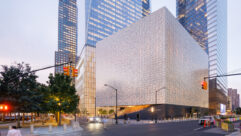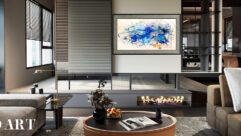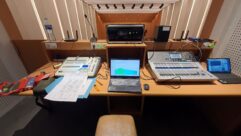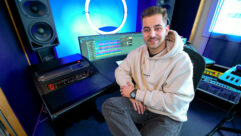The art of theater soundWhen used to create the imaginary world of the theater, sound is an integral part of the artist’s palette.
Jan 20, 1997 12:00 PM,
By Ken Bell, P.E.Bell is general manager at Richmond Sound Design in Vancouver, BC.
The study of theater sound is much like the study of old paintings, with schools of presentation from mini-malist to spectacular. Each work involves a detailed process, from the preliminary notes and sketches to the final and committed rendition. There is pure technique and a measure of judgment. Every aspect reveals just a little more about the central statement. Thus it is with theater sound. A cogent sound, like a great painting, is evocative. Through apparently normal means, it calls to attention something transcendent and more vital than expected.
FoundationIn a theater setting, sound serves several critical functions (Bracewell, 1993). Without audibility of dialogue, all plays (save mime) mean nothing at all. To assist in plot continuity, all sound effects must be in the right place at the right time. Theatrical music may be incidental or thematic as the underscore or the integral score. Vocal alteration or substitution is spatially attributed to either the actor or some related stage object. Also, sound extends dramatic space and time beyond that of the physical stage and sets the mood of the performance.
As Kaye and LeBrecht point out, in playwriting not a single word is arbitrary; so it is with sound (Kaye and LeBrecht, 1992). Sound should be precisely suited to the action, no matter the production style. Sound can rarely be literal or overstated. We are normally so immersed in sound that we seldom stop to separate the individual components except through thediscipline of theater.
Within the theater, auditory space consists of the performers’ voices, footsteps, music and the natural and synthetic sounds completing the imagined environment. Although soundeffects from property devices are still viable (especially the use oftheatrical bomb tanks), today’ssound designers usually work with an electronic playback and soundreinforcement system.
LayoutAlthough theatrical performances occur in any and all spaces, evenradio, the purpose of a theater’s layout is to improve communication. Aside from more extreme formsof theater (for example, where the performers surround the audience) only three basic canvasses exist: proscenium, thrust and in-the-round.(See Figure 1.)
A proscenium theater houses the stage separately from the audience. This both frames the action and permits a larger installation of technical equipment. Proscenium construction comprises the large majority of civic multipurpose spaces, not to mention the numerous theaters converted from former cinemas. These types of auditoriums usually seat anywhere from 500 to 3,000 people.
Broadway, in particular, has a large concentration of proscenium houses. The framing effect of the proscenium promotes a cinematic approach to scene changes, with curtains roughly equaling a fade, and moving scenery roughly approximating a cut. In cinema fashion, the action is viewed from one direction only. Although most multipurpose venues employ anoutward fan, a trend toward a box-like cinema shape has begun, recently emphasized by private loges. Fromthe viewpoint of sound design, the proscenium stage identifies the visual direction from which soundmust emanate. Immersive effects outside this direction must be carefully handled so as not to distract.
An arena or thrust theater normally has an exposed stagehouse and an extended apron into the audience area, which itself wraps more completely around the stage. Many contemporary theaters use the thrust arrangement. A thrust theater promotes a view of the action from three sides, and stage settings include all of the potential acting areas in view at once. Scene changes are more common with lighting changes than scenery movements. From the sound designer’s viewpoint, vocal action must be appropriately localized even though coverage demands have increased enormously. But the audience is freed from a cinematic point of view and is thus more susceptible to extensions in dramatic time and space.
Theater-in-the-round is still largely experimental. The central technical core is entirely exposed, and the sound designer can rely on few techniques of natural acoustics, but the surroundings do lend themselves to bold and innovative sonic statements.
The canvasThe vocal requirements for natural theater resemble those of a classroom or lecture hall. A generalized ETC (energy-time curve) for a proscenium-style theater (see Figure 2) shows a strong first cluster of arrivals, with moderate decay. This is hard to obtain in a large room and may be difficult even in a smaller building because the overhead reflector required is usually in conflict with lighting apparatus. Following the early arrivals at some distance are dense and diffuse reflections, ideally from the sides of the room. The space between early and diffuse arrivals “voices” the set, helping the audience localize action from reflections off the scenery. Where the staging uses sparse settings, this effect has a noticeable tone. Although voicing is useful, it is important that late arrivals do not fall outside the time-level envelope invoked by the first arrivals. As is normal for “dry” lecture characteristics, the late arrivals decay rather quickly.
Typical RT60 figures for theaters range from 0.7 seconds in the smaller room (a minimum of 150 m3 is suggested for adequate modal density) to 1.3 seconds in a larger house(typically 15,000 m3). Longer reverberation causes sonorousness, whichhas been used for epic stagings. Figure 3 shows measurements takenon the centerline at a midsized community theater.
More contemporary metrics C50 and C80 are used in the measurement and model testing of designs completed using rigorous traditional methods. Most acousticians are extremely cautious in interpreting these new quantities and do not publish the metrics as performance criteria. C80 compares the energy arriving before 80 ms with all energy afterwards. In concert halls, this figure is suggested to measure clarity. C80 is predicated on an 80 ms limit for the perceptibility of music. Its contribution in spoken or multipurpose theater is circumspect, because a good value can disguise a multitude of problems. However, a higher number does suggest earlier sound arrivals and presumably more intelligibility. The related metric C50, based on the 50 ms limit for perception of speech, appears to be a more widely accepted statistic. The early decay time (measured over the first 10 dB of decay by EDT10) affectsthe subjective impression ofliveness. Strong and extended early arrivals increase this apparentreverberation time.
None of these values accounts for the direction of arriving sound. Normally, the designer plans the geometric solution to satisfy both spatial and energy criteria. Hence the metric L, which compares the energy from the direct path with energy arriving from all other paths, may prove usefulin new work, especially as “surround-sound” becomes a common part of the theatrical presentation.
The performer’s footsteps are as important as the performer’s voice, but a certain noise threshold should be maintained. The quietest theater should have a background noise criterion of no less than NC-20, and you can imagine the acoustic self-discipline required of performers and technical crew under these settings. Things are much more tenable if ambient noise is kept in the range of NC-25 to NC- 30. Above NC-40, the surroundings can be distracting, except for the most heavily amplified settings. Mind you, these often have moving lights, moving scenery and no end of other noisy things.
The paletteIn the simplest theaters, naturally reinforced stage action is supplemented by sounds from effects properties such as the thunder sheet and door frame. Much more commonly, a playback sound system complements the natural stage action with sound effects and music. (See Figure 4.) For many years the cornerstone of theater sound was the reel-to-reel tape deck, with leader tape spliced between the individual sound cues. Many reeldecks still exist (nightly reliability was apparently a big selling point)although trends are toward CD cart, hard drive, RAM sample, CD-ROM playback or digital audio workstations, which have been specified as playback engines, although are more useful in the early stages of production.
Depending on the theater style, a small acoustic or locally amplified musical combo may naturally reinforce the spoken action. More and more, small ensembles use MIDI to extend the ranges of instrumentation, and the use of MIDI to simulate larger orchestras is becoming common.
Theater sound becomes challenging when both the performers and orchestra must be amplified. Foot microphones, stand microphones and occasionally overhead microphones have traditionally been used to acceptable effect if movements are carefully blocked and the performers are conscientious about projection. Nonetheless, it is rare to find a mainstream production without wireless microphones. A full-scale musical will likely use no less than 20 microphones; the upper limit is anyone’s guess. In such productions, close microphones permit the use of monitors, and source independent measurement (SIM) techniques are often used to tailor each microphone response to its position on the performer. In larger musicals, the console is equipped with a matrix to adjust each microphone to proper stage position, usually within a panorama of six channels. As with other stage equipment, the microphones take a beating, and all sorts of techniques for the care of microphones have evolved. Also, frequency coordination is increasingly becoming a problem in our largest cities.
Traditional theater uses fewer microphones but more complex matrix arrangements. Harold Burris-Meyer and Vincent Mallory, working at the Stevens Institute of Technology in the 1930s, were the first to combine mix-down with fan-out capabilities. Their 1952 book (later published with Goodfriend, 1959) is an outstanding compendium of methods, including some psychoacoustic techniques.
Sanford elaborates on the requirements of a truly malleable sound system, including the ability to position anywhere in the hemispherical space, to transit between point and diffusive sources and to extend radially forward or backward in apparent distance (Sanford, 1973). Of course, these features must be automated in accordance with the sound designer’s wishes for repeatable nightly cueing, but must also be manually responsive, within limits, for interpretive and relative controls. At the core of such a system is a digitally controlled dynamic matrix, with related signal processing. Only a few manufacturers (including our company) provide such systems intentionally for theater. As a general rule, theatrical matrix systems are used in conjunction with a standard or automated console. In the latest versions, these systems uniformly use DSP techniques for the utmost in manipulation.
Advanced mediaFull multichannel delivery systems are often confused with the simpler surround techniques of cinema. Cinematic surround typically uses six channels: left, center, right, left rear, right rear and subwoofer. A minimal theatrical configuration uses eight channels, with systems routinely using 24 or 32 channels. Theoretically, 64 channels would entirely cover a hemispherical perspective within the resolution of average auditors. More channels are normally required when loudspeakers are placed closer to individual audience members.
Because the imagined theater space is entirely evocative, some unusual delivery systems have evolved. One famous designer uses unbaffled 12 inch (305 mm) loudspeakers to great effect, although seemingly contrary to the experience of most reinforcement comments. In the voice band, the cone apparently provides adequate baffling against the rear wave, and the result is added to the vocal mix for an unusual signature effect. Even more unusual is the work done with M-S (middle-sides) recording. Originally used because L-R stereo could be derived from the combination of a cardioid and a figure-eight, the new technique uses the middle cardioid as a monaural house source, with varying amounts of the side figure-eight dialed into the surrounds (almost as “antimono”). Of course, to prevent localization, the loudspeakers intended for immersive surround must have diffuse dispersion (often accomplished by aiming away from the audience) and are generally fed delayed signals.
For a consistent patron experience, the transitions between individual sounds and between sounds and silence must be repeatable night after night. Dedicated show sequencers, designed for live action, normally combine manually executed commands with time-coded segments and events triggered by stage action. MIDI Show Control, the theatrical cueing extension to MIDI, was developed through mutual efforts of the sound and theatrical lighting industries and portends development of what has come to be called interactive theater.
Although interactivity has long been heralded, each day the enabling technologies get stronger. Developers of computer games have created sophisticated and immersive 3-D algorithms, complete with dynamic tracking, for single listeners over headphones. The next generation of computers already includes basic 3-D capabilities. The MIDI Manufacturers Association, with major hardware and software companies, is working to identify standard (and ultimately transmissible) architectures for sound generation, using “agile” sound samples.
For the time being, computer 3-D techniques do not directly scale to larger multichannel audiences, and most sound movements will continue to be accomplished by simple pans. Show development is a high-pressure environment, and as everywhere, sound designers must invariably trade some accuracy for expediency. However, computer 3-D models could serve as design simulations in conjunction with a separate, properly scaling model. In fact, even the simulation of natural reinforcement might be attempted, because a loudspeaker can mimic a reflection. As the cost of computers and digital equipment comes down, more and more designers will use these tools routinely.
Must the artist starve?It’s encouraging, at the end, to see that sound is no longer a novelty in the theater. Once a producer discovers the value of sound and music to a presentation, future use is much more likely, and permanent and production sound budgets are less likely to be afterthoughts. Alternatively, sound is often used to cover budget deficiencies in other display elements, and many a sound designer ends up co-producing a show by purchasing studio time or media out of an already modest fee. Contractors, of course, have a similar litany of examples. We must all try to know and explain the significance of sound and music in theater and what the work entails. Nowhere does the history of art maintain that an artist has to starve.
ReferencesJohn Bracewell, Sound Design in the Theater, Prentice Hall, 1993.Harold Burris-Meyer and Vincent Mallory (and Lewis Goodfriend), Sound in the Theater, Theater Art, New York, 1959.Dena Kaye & James LeBrecht, Sound and Music for the Theater, Backstage Books, 1992.J.L. Sanford, “Performance Criteria for Theatrical Sound Effects Systems,” parts I and II, JAES, May, Sept. 1973.
Additional referencesYoichi Ando, Concert Hall Acoustics, Springer Verlag, 1985. (Where most of the advanced metrics originated.)Durand Begault, 3-D Sound for Virtual Reality and Multimedia, Academic Press, 1994. (Read this, and talk 3-D.)David Collison, Stage Sound (poss. 2nd edition), Drama Publishers, 1976.The Complete MIDI 1.0 Detailed Specification (v 95.1) available from the MIDI Manufacturer’s Association, La Habra, CA (310) 947 8689.Don and Carolyn Davis, Sound System Engineering, 2nd Edition, SAMS, 1987. (See S&VC Jan 20, 1995 for a summary of Davis’s excellent design technique.)John Eargle, Handbook of Sound System Design, ELAR, 1989.Patrick Fanelli, Sound for the Stage, Drama Book Publishers, 1989. (Good intro for the lay student, although somewhat casual to an experienced practitioner.)Michael Green, Stage Noises and Effects, Jenkins, London, 1958. (Traditional approaches to thunder, bombs, and so on)Marvin Kerner, Art of the Sound Effects Editor, Focal, 1989. (Good description of film sound, including foley and audio posting.)Brenda Laurel, Computers as Theater, Addison Wesley, 1991.Frank Napier, Noises Off, Miller, London, 1936. (Buggy whips for pistol shots – some of this stuff still works!)Norman Potts ed., Theater Technology & Design, International Thespian Society, 1984.Wayne Wadhams, Sound Advice, Schirmer, 1990. (A musician’s guide to the studio, but has lots on microphone techniques for recording.)Walne, Graham, Sound for Theaters, Offord/City Arts, 1981.










